
- Privacy Policy
- Affiliate Disclosure
- Recommended Resources

How to make a working from home agreement with your employer (template included)
- Make sure the timing of you asking to work from home makes sense.
- Research whether your office already has a working from home policy. This knowledge will help you when you approach your manager.
- Deciding where your home base will be is an important element.
- Make a compelling case to your employer that you can work effectively from home. Show, don't tell.
We have put together this post so both employees that want to work from home and managers who are looking at frameworks for having their staff work remotely can have access to everything that is necessary for a working from home agreement. This will be a document agreed upon by both sides, outlining both side’s commitments for remote working. Feel free to jump right to our downloadable Working From Home Agreement template or keep reading for some details on what makes up the agreement and how to prepare for writing one.
Tool: Working from home agreement template
We have carefully laid out what exactly needs to be in a working from home agreement. Feel free to download our template to use yourself whether you are an employee or a manager.
Deciding to make teleworking official with your employer
First, you need to decide whether you are the type of person that wants to work from home. This doesn’t mean you need to be 100% remote, but you should figure out for yourself whether this is the time to make it official with your employer. A few things to keep in mind.
Is the time right to request to work from home?
Make sure the time is right. Do your managers have some time to consider your request? Would it actually make sense for you to be working from home right now? Each job is different, but you want to make sure you are asking during a good window of time. Perhaps it is during a pandemic when most are already working from home. You’d just be making it official. But perhaps if there is a lot of hands-on physical work and in-person meetings scheduled for the immediate future, this would not be the best time.
Prove that you are able to work from home
Whether you like it or not, a lot of employers are still a bit wary of the idea of a distributed working from home workforce. The absolute best thing you can do to make the case to your manager is to actually prove that you are capable of remaining productive and useful while working from home. Truth be told, not everyone is cut out for a work from home lifestyle. So consider working from home a few days per week to prove to your boss that you can do the work from a distance.
This is also about timing. Slowly build-up trust with your manager and check in with them regularly to show that you can effectively communicate progress on key projects. Set up systems for accountability that would be easily done in a remote work situation so it is less of a stretch when you do ultimately ask to work remotely.
Where will your home base be located?
A key piece for many employers is having employees available for the odd face-to-face meeting at the office. Will your home be located in the same city? Would it be easy to make a couple of trips to the office per month if your manager needs it? Or will you be moving your family to another geography and fully working remotely? These are good things to clarify with both yourself and your family before you consider taking the next steps. And consider what preference your supervisor might have in terms of having employees living in the same city as the main office.

Is there already a teleworking policy at your office?
You need to do your homework before asking your manager to switch you to a working from home scenario. Does your office already have some kind of teleworking policy ? Have others already been working remotely from home? If there is a precedent you could consider reaching out to one of those colleagues to see the process they went through. Also, consider checking in with your human resources department about company resources around remote work. You might be surprised to see that there are mechanisms in place for part-time and full-time work from home.
Become familiar with what is actually in the teleworking policy . Are there stipulations that might limit your ability to do your job from home? Does this policy still reflect the reality that we saw during COVID-19? Perhaps some things at your office have changed since then and working from home is now much more accepted. This might be a scenario where the policy needs to be tweaked, given the “new normal” that we all face.
For Employees:
Contact your HR department and check to see if there is already a teleworking policy. This will likely also be available in your employee manual and perhaps on your company intranet.
For Managers:
COVID-19 has shown a lot of workers that working from home is a viable option. If your company currently does not have a working from home teleworking policy, it is time to make one!
Justifying a working from home arrangement with your manager
Full time, part time or temporary telecommuting agreements.
When you approach your manager be as clear as possible about what you are proposing. Is this a temporary situation of working from home (for example, due to COVID-19) or are you looking for a more long-term working from home arrangement? Consider starting out small. Propose to your manager that you would like to “try out” working from home for 1-2 days a week. Slowly build up some trust with your manager and show them that you can actually put in the hours and be productive. As mentioned above, prove to them that this is a good move. Show up early to meetings. Dress like you are at the office. Contribute to your team at a high level. All of these things will help convince your manager that working from home might actually be the perfect arrangement.
Make a compelling case to work from home
When you are asking to drastically change your working model, you need to be sure that have come up with a compelling case. It’s not enough to just say that you hate the commute. That might be true, but you need to show why working from home with actually benefit your employer and not just yourself. Talk about how you might be able to put in more hours from home without a commute. Perhaps mention to your manager that you would no longer need a permanent desk at the office. Those desks are actually quite expensive and they might need the room. But most of all, mention how much more productive you can be from home. In short, by working from home you will be improving the efficiency of your office.
A few elements that can make a compelling case to work from home:
- Will you be more productive? For example, do you do a lot of writing that can benefit from working from home?
- How would you do a better job in your position if you worked remotely?
- How would you be more available if you worked from home? For example, perhaps without the commute, you could be available for earlier and later meetings.
- Do you have the technology to effectively work from home (ie. a good internet connection)
What should be in a working from home agreement?
Once you have confirmed whether your office has a working from home policy , then you may want to see if a formal request template or working from home agreement template is already made. If so, then this is obviously what you would use to come up with an agreement with your manager. In many cases, the manager or senior staff would actually be the one that works on the agreement, so consider this a time for collaboration on an agreement that works for both of you. If this is the first time your manager has worked with a staff member on a formal work from home agreement, they might appreciate the work you do on this. Make it easy on them! The more prepared you are, the easier it is for them to say yes.
But let’s stop beating around the bush. What should actually be in a working from home agreement? We have outlined some of the main elements that would need to be in this agreement in our downloadable PDF (also available in Word, and Google Docs), but we will cover the basics here.
*Please note that Home Werker is not a law firm and this document does not represent legal advice for either employees or companies. Agreements such as these should align with official company policy and be reviewed by trained legal experts.
Elements of a working from home agreement
A summary proposal.
Think of this section like a cover letter on a resume. This is a summary of you making your case. You can mention all of the justifications from above that make working from home a compelling solution for your particular job. Remember, what are the benefits to the company? How will working from home make you a better and more efficient worker?
You can also get into how you will manage to shift things you normally did from a traditional office environment to working from home. What are your key roles in the business and how are those fulfilled from home? For example, how will you specifically maintain regular communication with your team?
If a working from home policy already exist, this is the place to make reference to that policy.
Eligibility
Is it actually possible to do this job from a distance? This section will outline the current job description and how a work from home model is appropriate for that work. Any areas where physical presence at an office is required or preferred should be spelled out in this section. It may be in your interest to keep an element of physical connection with your office if you are still going to be living in the same city. Even if it is going to the office 2-3 times a month. Spell this out so your manager knows what you are committing to.
Temporary or permanent
This section should outline the specific nature of the working from home situation. Is this a permanent shift or will this only be temporary? Perhaps consider adding a section about regular check-ins to see how a remote working model is progressing at regular intervals with your boss.
Effective date
When will you start working from home? Be specific. If you are easing into it, make that clear in this section.
Costs covered by the employer
Equipment: You’re going to need to procure the right equipment to make your home office a place you can work from. This will include where you will source your computer and other technology and whether this needs to be purchased specifically or whether your existing office laptop will be used. Things like company cell phones can also be included in this section. Make sure you will have everything you would normally have access to in an office (within reason). Be sure that your work covers a comfortable chair for you!
Office supplies : Depending on your role, you may need to have access to things like envelopes, pens, printer toner, etc. Make sure it is clear how these will be sourced and whether reimbursements will be made by the company and the policy that should be followed for this.
Maintenance of workspace: You may want to spell out how your work will maintain the different equipment, software, and other items that you will need on an everyday basis. Similarly, a clause around your responsibility to maintain any work property can be mentioned here.
Reimbursements: How will you be reimbursed if you purchase it for office use? What is eligible? What policy needs to be followed?
Other accommodations: Do you need any specific accommodations in order to work from home? This could include ways to customize your space if you have a physical impairment. If any specialized equipment is necessary, make sure it is spelled out here.
Do an inventory of what equipment and stationery you will actually need in your home office. Will you need a company phone? Or can you just have it forwarded to your personal phone? This is important to work out in advance.
Yes, having fewer employees taking up space in an office will save money. But you will need to decide on what technology and other accommodations need to be covered by the company before agreeing on a teleworking model.
Benefits and salary
Do your existing employment benefits apply the same way when you work from home? Clarify this in this section. Similarly, mention your current salary and how it should remain the same even when working from home. Salary reviews should continue in the same way as they would when in the physical office space. You, as the employee, will agree to all other job requirements like you are working from the office.
Are there any specific tax implications from remote work? Mention that you will be responsible to figure out any tax changes that may take place based on working from home. Many locations will give some tax breaks and refunds for those that use a room in their home solely for working. We recommend talking to a tax professional on this one as the intricacies of each locality can have very specific ramifications.
Availability and accountability
Work hours: What hours will you commit to working? If there are core work hours where all employees are expected to be available, mention that this will not change (unless for some reason it will). If you think you might be able to start earlier in the morning you may want to mention this here. After all, you won’t be commuting anymore!
Availability for in-face meetings: If you can dedicate yourself to some regular visits to the physical office, mention what would be ideal here. We recommend maintaining some form of physical visits with the office if only to maintain social connections. Many managers will appreciate your committing to this.
Time tracking: In order to maintain trust, commit to using company-wide time tracking. Whatever form of tracking is the norm, use this. If nothing is currently in effect, you should talk to your manager about what would be acceptable to keep you honest here. Many organizations will require some kind of timesheet, time tracking, etc. for audit purposes.
Responsiveness and expectations around contact: Explain your commitment to being available on channels like Google Chat, Slack, Microsoft Teams, and email. Specifically, outline what hours you are expected to be responding to messages on a normal basis.
What is your company’s policy around overtime? While working from home it can be easy to fall into a habit of working longer hours than usual. Should these hours be logged as overtime? Or is it expected that some level of extra time is put in when working from home? What is the process for approving overtime with your employer? Clarify this with your manager. Be careful to not commit to unreasonable expectations here. Whatever is the norm for office workers should be the same here.
How should vacation be scheduled and communicated with the wider team? Are there any special stipulations for remote workers in terms of vacation time?
Security and inspection
Client confidentiality: It is expected that you will keep strong client confidentiality. This means that all of your digital tools will be secured and any physical files are secured in a locking file cabinet, limited to your workspace at home. If you have a particularly confidential role, you may have to undergo some kind of audit around the storage of files and information at your home.
Secure networks and IT: Outline the expectation you would have around the IT department setting up secure VPNs, proxies, file storage, and other digital security. Commit to keeping the same standard of security in your own local network as you would at the office. Since this is a technical area, consider talking with your IT department to find out what is necessary to get you up and running securely at home.
Inspection: Will a physical audit of your home’s security be necessary by the employer? Make note of that here. What kind of notice needs to be given for your employer to retrieve company property?
Consider whether your position needs access to top-secret information. What kind of digital and physical security will you need to have in place in your home office?
If a distributed workforce is a possibility for your company, how will you secure data? Make sure your IT department is on board to set up data management systems for remote employees.
Health and safety
Worker’s compensation and insurance: You should commit to keeping a workspace free of hazards, in line with company standards at the office. These minimum standards may need to be worked out with HR. Is your home environment insured? Will your workplace insurance cover you while working from home? It should, but this should be spelled out specifically in this agreement.
Liability: This would be a more legal section that would point towards policies around liability among work from home employees. Generally, the employee would be liable for injuries from their own premises.
Caring for dependents during work hours
This is an area that should be clear from the get-go. During COVID-19 it is understood that many parents and those with other dependents would need to take a reasonable time to care for these individuals during work time. During normal times, it should be clear that dependent care should not get in the way of normal office functions or availability. Just because you are working from home doesn’t mean you have the right to bring your kid to every online meeting. If you do need special accommodation it is recommended that you contact your manager and HR department to discuss your needs.

How to ask: Approaching your manager with a remote working agreement
This may actually take place before you even work on a template at all, depending on how much collaboration you are doing with your manager on the work from home agreement itself.
We recommend you approach the subject of requesting to work from home in an in-person meeting. A regular check-in may be the best time to approach this subject. Timing is everything! Have you done the leg work to make sure you can “make the case” that remote working will benefit the company?
Show you’ve done your research! Make sure you anticipate common issues employers may have and show you have a good answer to them. Here are a few points for you to be familiar with before you have the conversation with your boss:
- Can you ease into working from home? What if the manager offers you to work 3 days from home and 2 from the office?
- What hours can you work? Can you be flexible, given that you have now eliminated your commute? There may be an opportunity here, especially if your position deals a lot with other time zones. Make the case to your boss that this will be an asset to the organization.
- Is there already a working from home policy in place? If so, make sure you know it front and back.
- How will your specific job be done from home? Are there examples of agencies or other companies that do similar work remotely? Make sure you have these in your back pocket just in case your manager asks.
- How available can you be working from home? What tools will you use to show your manager that you are trustworthy and indeed getting the work done? We call this the “green” circle policy at my work. Make sure you are available on Google Chat, Skype, Slack, etc during core working hours.
When you finally meet with your superior, make sure you have (1) answers to the above at the ready and (2) your written proposal summary on paper. This would be the beginning of a work from home agreement that you would finalize with the help of your manager and HR department. Make it easy for your boss. Make sure they know that you are serious and have put in the research and work on this.
Be ready to counter any concerns that may come from your manager. But make sure it isn’t seen as being defensive. Instead, become an expert in this area. The more prepared you are the better.
You have likely seen how your employees performed from home during the COVID-19 pandemic. If you have a specific concern with this particular employee, be up-front. There may be a way to do a “trial” and slowly build-up trust in remote working.
Give it your all during a trial period
In many cases, your boss will want to “try it out.” Especially if they are also new to the idea of a distributed workforce. This is your chance to show them that you really mean business. For the period of your trial make it clear that not only are you just as productive as at the office, but you are way more productive and useful to the company.
You might be the first one giving this whole working from home thing a try in your team. Here are a few things you can do to prove that it wasn’t a mistake to let you switch to remote work:
- Be professional: Wear nice clothes to meetings and keep an overall professional tone to your work.
- Be on time: Be the first person to show up on a Zoom call. Always be ready to chat with the boss about your current work as you wait for others to join. You have you “stuff together”, make sure your manager sees that.
- Be available: Make sure you work at least the core hours of your organization. Go above and beyond within reason. Answer the odd Slack message that comes in late. Make it clear that you are even more reliable than you were when you were at the office. Make sure that “green dot” on your instant message platform remains green!
- Communicate, a lot: The biggest perceived downside of working from home is the lack of on-the-fly communication that is lost when you no longer see your team in the hallway. Replace this with regular video check-ins and ad-hoc meetings to show that you will make the effort to communicate.
If you do all of these things it should be smooth sailing. Essentially make it easy on your supervisor to realize that working from home does not mean a drop in productivity. In fact, it can mean the opposite. It’s your job to prove it to them!
Use our working from home agreement template
Whether you are an employee trying to figure out how to broach the subject with your manager or a supervisor looking to build an agreement for your employees, we think you will benefit from our Working From Home Agreement template . We have made it available in Google Doc, Microsoft Word, and PDF. Enjoy!

We're James and Maureen
We are two passionate international development professionals that work from home the majority of our time. We don't miss the commute!
90+ Free Zoom backgrounds - Disney, Marvel, Star Wars and more
How much do standing desks cost our favorite desks compared, steelcase leap vs gesture: which chair is best for you, steelcase gesture vs herman miller embody - which is better.

James Sawchuk
About author, related posts.
- Effective Time Management Strategies for Remote Workers
- The Future of Remote Work: Trends and Predictions for the Virtual Workspace
- How to Find Remote Jobs in the US: A Comprehensive Guide
It's time to breakup with the office
Get work from home tips, job-hunting resources and more...
- Pingback: Part Time Work From Home Into a Reality - Free and Remote
Leave a Reply Cancel reply
Your email address will not be published. Required fields are marked *
Save my name, email, and website in this browser for the next time I comment.
The 6 tools you need to manage remote team communications
- Cookie Policy
- Recommended Work From Home Resources
Recent Posts
It's time to breakup with the office.

Homeworking agreement template
Value bundles that include this:
Why this template is necessary Compliance notes The template A purchase is required to view Specifications
Our Homeworking Agreement Template supports remote work arrangements, outlining clear expectations for both employers and employees.
If an employee is due to commence a period of homeworking, this model homeworking agreement template outlines the applicable terms and conditions.
It is designed to be used where either a new or existing employee has agreed that their main place of work will be elsewhere than the employer's office, or in any event in a location which is not under the control of the employer.
It should be distributed to employees before they commence a period of homeworking.
Why this template is necessary
With the right to request flexible working now extended to all employees, not just parents or carers, home working may well become more popular amongst employees seeking greater flexibility. As such, as well as utilising this agreement, it is advisable that employers have a Homeworking policy setting out how any requests by employees will be dealt with.
This template is drafted to ensure that employers meet all of their legal obligations to their employees whilst ensuring that the work they receive is still of the standard that they might expect if the employee was in a more controlled environment.
All businesses should undertake a Risk Assessment for employees working from home.
Compliance notes
Employment Rights Act 1996: Addresses terms and conditions, including the provision of flexible working arrangements.
Health and Safety at Work Act 1974: Requires employers to ensure a safe working environment for remote workers.
Data Protection Act 2018: Ensures data security and confidentiality for remote working arrangements.
Equality Act 2010: Prohibits discrimination, including ensuring equal opportunities for remote workers.
Working Time Regulations 1998: Defines working hours and rest periods, even for remote workers.
National Minimum Wage Act 1998: Ensures remote workers are paid at least the minimum wage.
Specifications
Homeworking agreement
Introduction
This agreement confirms the terms and conditions that will apply to you as a homeworker. Other terms and conditions are included in your written statement of particulars [ as well as the employee handbook ].
Reporting relationship
While working at home, you will report to [ name of manager ].
You will be paid a fixed amount of £[ amount ] every [ week/month ] while working from home. Overtime will not be paid unless [ name of manager ] expressly authorises it in writing in advance.
For each [ item produced/piece of work performed ], you will be paid a 'fair piece rate' of £[ amount ].
Each week, the minimum amount of work to be completed is [ x pieces ]. The maximum quantity of work that should be accomplished each week is [ y pieces ]. ]
You will perform the following duties at home: [ list work duties ].
[ When working from home, you must plan to deal with the potentially conflicting demands of job and family, and you must strive to be organised and disciplined. ]
Hours of work
You are not required to work specific hours and are free to do the accepted tasks whenever it is convenient for you.
However, there are some hours when you must be accessible to respond to phone calls or meet with management. These core hours are from [ time ] to [ time ] on [ weekdays ].
[ Company ] will generally expect you to contact your manager [ once a day/twice a week/once every two weeks ].
Rest breaks
You must take adequate rest periods as defined by the Working Time Regulations 1998. You must also:
- where work continues for more than six hours, take a 20-minute break and stop working during that break;
- ensure that you have a daily rest break of at least 11 continuous hours, i.e. the time between stopping work one day and beginning work the next day must not be less than 11 hours; and
- have at least one complete day each week when no work is done.
If you are sick and are unable to work, you must notify your manager as soon as possible, including the nature of your sickness and how long you expect to be absent from work. In these situations, [ Company's ] standard sick pay policy and process will apply.
Visits to [ Company ] premises
You are required to attend [ Company ]'s premises at [ address ] upon request for reasons such as training, performance evaluation, and team briefings. This will generally be no more than [ one day per month/half a day per month/two days per month/one day per week ], with the dates and hours agreed upon in advance.
You will be paid for time spent at the workplace on such visits at [ your normal rate of pay/some other rate ].
No additional payment will be made to you for time spent at the workplace on such visits. ]
Performance management
Your manager will conduct a performance assessment with you [ every six months/once a year ], in accordance with [ Company ]’s standard appraisal policy. The assessment will include a discussion of the specific issues associated with homeworking and any problems or issues that you have experienced or that the manager believes have arisen.
Visits to your home
Management reserves the right to visit you at home at agreed times for work-related purposes, including health and safety matters. It is a condition of this homeworking agreement that you agree to accept visits from management in your home. Such visits will be for the purposes of [ choose the relevant points and expand on them as necessary ]:
- delivering and collecting work;
- providing a channel for reporting;
- performance monitoring and feedback;
- general discussions about work-related matters;
- ensuring health, safety and security; and
- any other work-related purposes that [ Company ] considers appropriate.
Equipment and materials
It is [ Company ]’s policy that all equipment [ including computer equipment, and materials necessary for you to work at home ] will be provided to you by [ Company ] and maintained (and replaced when necessary) by [ Company ].
It is your duty to ensure that proper care is taken of equipment and materials provided by [ Company ].
Specifically, [ Company ] will provide:
- a [ laptop ] computer;
- a photocopier;
- a fax machine;
- a mobile telephone;
- a filing cabinet;
- [ other items as appropriate ].
On termination of your employment for any reason, [ Company ] will have the right to visit your home at an agreed time and retrieve all equipment, furniture and documents belonging to [ Company ].
Telephone and internet accounts
[ Company/You ] will pay the costs of connection fees for all telephone and internet connections in your home.
[ Company ] will reimburse you for all telephone and internet accounts associated with the use of your telephone and [ laptop ] computer used in connection with [ Company ]'s business. Claims should be made monthly on [ Company ]'s expenses claim form.
[ [ Company ] will pay all the bills for calls made by you on the mobile phone provided by [ Company ] to you, which must be used only for work-related purposes. ]
Stationery and postage
You should obtain receipts for any stationery purchased and any items posted in the course of your work and reclaim the costs from [ Company ] once a month, using [ Company ]'s expenses claim form.
You must carry out your work for [ Company ] in a room used only for that purpose and must not allow members of your family or third parties who are not employed by [ Company ] to access or use [ Company ] equipment.
[ You must also agree not to smoke in the room where the work is carried out. ]
You are responsible for keeping all documents and information associated with [ Company ]'s business secure at all times. Specifically, you are under a duty to:
- keep filing cabinets and drawers locked when they are not being used;
- keep all documentation belonging to [ Company ] under lock and key at all times except when in use; and
- set up and use a unique password for the computer.
Further, the computer [ and other equipment ] provided by [ Company ] must be used only for work-related purposes and must not be used by any other member of the family at any time or for any purpose.
Health and safety issues
[ Company ] is obliged under health and safety legislation to ensure the health and safety of homeworkers in the same way as for office-based staff. [ Company ] will therefore take appropriate steps to ensure that:
- all equipment and systems of work in your home are safe;
- all articles and substances are safely handled and stored;
- an analysis of your workstation is conducted;
- information and training on the safe use of equipment, including display screen equipment, is provided to you; and
- risk assessments are carried out in respect of the work that you are carrying out.
You have a duty to ensure, insofar as is reasonably practicable, that you work in a safe manner and follow all health and safety instructions issued by [ Company ] from time to time.
You are responsible for checking that all home and contents insurance policies provide adequate cover for the fact that you work at home.
If there is any uplift in the premium for any of these home insurance policies specifically on account of the work for [ Company ], [ Company ] will meet the appropriate extra premium upon provision by you of the appropriate documentation and receipts.
A purchase is required to view Protected content : Make a Purchase to unlock.
Why choose our Homeworking agreement template ?
Our content:.
I have just renewed our membership for another year for HRdocbox. It's an extremely useful resource with a wide variety of documents and knowledge... ★★★★★ - Rachel Masing, ETM Group
I have previously posted a review on their service, however thought I should add an update. I have just signed up with them again... ★★★★★ - Jamie Allan, Armstrong Craven
Excellent library of resources and templates which have made my job in my small business so much easier to manage HR for my employees... ★★★★★ - Emma Hunt
Great value and the site contains an extensive library of essential HR documents. I access the site probably once a week... ★★★★★ - Laura Alliss-Etty
HRDocBox is a great resource. It is incredibly good value, providing a large selection of HR guidance materials as well as... ★★★★★ - Emma Beauchamp

Before you go...
As a thank you for considering us, below you will find an introductory discount code for 20% off anything ! Just use it when you checkout.
Join thousands of businesses that have used hrdocbox.co.uk to streamline their HR, reduce risk, and enhance efficiency.
Still not sure? Have you taken a look at our FREE templates to see our quality of content? View them here.
Homeworking agreement
Our Homeworking Agreement Template supports remote work arrangements, outlining clear expectations for both employers and employees.
If an employee is due to commence a period of homeworking, this model homeworking agreement template outlines the applicable terms and conditions.
It is designed to be used where either a new or existing employee has agreed that their main place of work will be elsewhere than the employer's office, or in any event in a location which is not under the control of the employer.
It should be distributed to employees before they commence a period of homeworking.
What is a Homeworking agreement?
With the right to request flexible working now extended to all employees, not just parents or carers, home working may well become more popular amongst employees seeking greater flexibility. As such, as well as utilising this agreement, it is advisable that employers have a Homeworking policy setting out how any requests by employees will be dealt with.
This template is drafted to ensure that employers meet all of their legal obligations to their employees whilst ensuring that the work they receive is still of the standard that they might expect if the employee was in a more controlled environment.
All businesses should undertake a Risk Assessment for employees working from home.
What legislation and best practice guidelines have been taken into account in the development of this template?
Employment Rights Act 1996: Addresses terms and conditions, including the provision of flexible working arrangements.
Health and Safety at Work Act 1974: Requires employers to ensure a safe working environment for remote workers.
Data Protection Act 2018: Ensures data security and confidentiality for remote working arrangements.
Equality Act 2010: Prohibits discrimination, including ensuring equal opportunities for remote workers.
Working Time Regulations 1998: Defines working hours and rest periods, even for remote workers.
National Minimum Wage Act 1998: Ensures remote workers are paid at least the minimum wage.
Consult your jurisdiction's employment legislation or labor laws to ensure compliance with the template. Review the language for local precision.
Introduction
This agreement confirms the terms and conditions that will apply to you as a homeworker. Other terms and conditions are included in your written statement of particulars [ as well as the employee handbook ].
Reporting relationship
While working at home, you will report to [ name of manager ].
You will be paid a fixed amount of £[ amount ] every [ week/month ] while working from home. Overtime will not be paid unless [ name of manager ] expressly authorises it in writing in advance.
For each [ item produced/piece of work performed ], you will be paid a 'fair piece rate' of £[ amount ].
Each week, the minimum amount of work to be completed is [ x pieces ]. The maximum quantity of work that should be accomplished each week is [ y pieces ]. ]
You will perform the following duties at home: [ list work duties ].
[ When working from home, you must plan to deal with the potentially conflicting demands of job and family, and you must strive to be organised and disciplined. ]
Hours of work
You are not required to work specific hours and are free to do the accepted tasks whenever it is convenient for you.
However, there are some hours when you must be accessible to respond to phone calls or meet with management. These core hours are from [ time ] to [ time ] on [ weekdays ].
[ Company ] will generally expect you to contact your manager [ once a day/twice a week/once every two weeks ].
Rest breaks
You must take adequate rest periods as defined by the Working Time Regulations 1998. You must also:
- where work continues for more than six hours, take a 20-minute break and stop working during that break;
- ensure that you have a daily rest break of at least 11 continuous hours, i.e. the time between stopping work one day and beginning work the next day must not be less than 11 hours; and
- have at least one complete day each week when no work is done.
If you are sick and are unable to work, you must notify your manager as soon as possible, including the nature of your sickness and how long you expect to be absent from work. In these situations, [ Company's ] standard sick pay policy and process will apply.
Visits to [ Company ] premises
You are required to attend [ Company ]'s premises at [ address ] upon request for reasons such as training, performance evaluation, and team briefings. This will generally be no more than [ one day per month/half a day per month/two days per month/one day per week ], with the dates and hours agreed upon in advance.
You will be paid for time spent at the workplace on such visits at [ your normal rate of pay/some other rate ].
No additional payment will be made to you for time spent at the workplace on such visits. ]
Performance management
Your manager will conduct a performance assessment with you [ every six months/once a year ], in accordance with [ Company ]’s standard appraisal policy. The assessment will include a discussion of the specific issues associated with homeworking and any problems or issues that you have experienced or that the manager believes have arisen.
Visits to your home
Management reserves the right to visit you at home at agreed times for work-related purposes, including health and safety matters. It is a condition of this homeworking agreement that you agree to accept visits from management in your home. Such visits will be for the purposes of [ choose the relevant points and expand on them as necessary ]:
- delivering and collecting work;
- providing a channel for reporting;
- performance monitoring and feedback;
- general discussions about work-related matters;
- ensuring health, safety and security; and
- any other work-related purposes that [ Company ] considers appropriate.
Equipment and materials
It is [ Company ]’s policy that all equipment [ including computer equipment, and materials necessary for you to work at home ] will be provided to you by [ Company ] and maintained (and replaced when necessary) by [ Company ].
It is your duty to ensure that proper care is taken of equipment and materials provided by [ Company ].
Specifically, [ Company ] will provide:
- a [ laptop ] computer;
- a photocopier;
- a fax machine;
- a mobile telephone;
- a filing cabinet;
- [ other items as appropriate ].
On termination of your employment for any reason, [ Company ] will have the right to visit your home at an agreed time and retrieve all equipment, furniture and documents belonging to [ Company ].
Telephone and internet accounts
[ Company/You ] will pay the costs of connection fees for all telephone and internet connections in your home.
[ Company ] will reimburse you for all telephone and internet accounts associated with the use of your telephone and [ laptop ] computer used in connection with [ Company ]'s business. Claims should be made monthly on [ Company ]'s expenses claim form.
[ [ Company ] will pay all the bills for calls made by you on the mobile phone provided by [ Company ] to you, which must be used only for work-related purposes. ]
Stationery and postage
You should obtain receipts for any stationery purchased and any items posted in the course of your work and reclaim the costs from [ Company ] once a month, using [ Company ]'s expenses claim form.
You must carry out your work for [ Company ] in a room used only for that purpose and must not allow members of your family or third parties who are not employed by [ Company ] to access or use [ Company ] equipment.
[ You must also agree not to smoke in the room where the work is carried out. ]
You are responsible for keeping all documents and information associated with [ Company ]'s business secure at all times. Specifically, you are under a duty to:
- keep filing cabinets and drawers locked when they are not being used;
- keep all documentation belonging to [ Company ] under lock and key at all times except when in use; and
- set up and use a unique password for the computer.
Further, the computer [ and other equipment ] provided by [ Company ] must be used only for work-related purposes and must not be used by any other member of the family at any time or for any purpose.
Health and safety issues
[ Company ] is obliged under health and safety legislation to ensure the health and safety of homeworkers in the same way as for office-based staff. [ Company ] will therefore take appropriate steps to ensure that:
- all equipment and systems of work in your home are safe;
- all articles and substances are safely handled and stored;
- an analysis of your workstation is conducted;
- information and training on the safe use of equipment, including display screen equipment, is provided to you; and
- risk assessments are carried out in respect of the work that you are carrying out.
You have a duty to ensure, insofar as is reasonably practicable, that you work in a safe manner and follow all health and safety instructions issued by [ Company ] from time to time.
You are responsible for checking that all home and contents insurance policies provide adequate cover for the fact that you work at home.
If there is any uplift in the premium for any of these home insurance policies specifically on account of the work for [ Company ], [ Company ] will meet the appropriate extra premium upon provision by you of the appropriate documentation and receipts.

- 601 HR docs & templates.
- 500+ supporting resources.
- Be prepared for any HR challenge.
- Homeworking agreement included.
Management library
- 305 Management templates.
Flexible and hybrid working templates toolkit
- Job Evaluation Tool
- Salary Search
- Business Healthcheck
- Model documents and policies
Business principles
Discipline and grievance, dispute resolution, employee relations, employees and workers, family friendly and flexible working rights, managing absence and capability, pay and benefits, recruitment and selection, termination, terms and conditions, homeworker agreement.
- Templates and Tools
- Flexible working
This document should be distributed to all staff before they commence a period of homeworking. It outlines the terms and conditions of their homeworking arrangement alongside confirming that the organisation reserves the right to cancel this arrangement at any time. It also includes a clause outlining the arrangements should an exceptional circumstance arise, such as pre-planned blackouts or power cuts.
Content type
Download type.
- 02074940118
- [email protected]
Working From Home Policy (HR Guidelines)
Anne morris.
- 5 August 2022
IN THIS SECTION
With more employees than ever working from home, employers must ensure they have a working from home policy in place that is clear on standards and expectations for remote workers, while ensuring legal compliance and protecting their interests.
In this guide for employers, we share an overview of the law relating to working from home, including an employer’s legal responsibilities toward their employees, and what a working from home policy should include as a matter of best practice.
The law on working from home
Homeworking is where a member of staff is permitted to carry out their daily contractual duties from home on an occasional, temporary or permanent basis.
The employee will typically still work in accordance with the core conditions under their contract of employment, such as the same working hours and pay, but will not be required to go into their official place of work for those days where working remotely has been agreed on hybrid working basis .
Working from home is a type of flexible working arrangement that can enable employees to meet the demands of their job role while providing a degree of flexibility to achieve a better work/life balance.
There are also various benefits to homeworking for your business, including lowering overhead costs, freeing up office space, and a happier and potentially more productive workforce with improved staff retention.
There is no legal right to work from home .
Employees have the right to request flexible working after accruing 26 weeks’ continuous service . As an employer, you do not have to agree to any such request by law, although you are legally required to consider a request made and provide sound business reasons for any refusal.
What are an employer’s responsibilities for homeworkers?
By law, all employers are under a duty of care to ensure the health, safety and wellbeing of their employees, including when an employee works from home.
Ordinarily, you would be expected to carry out some form of health and safety risk assessment of the workspace available within the employee’s home environment. A risk assessment can still be completed, even in the current climate, by way of an employee questionnaire, ensuring that every individual feels that the work they are being asked to do can be achieved safely at home.
You will be responsible for ensuring that employees have access to the right equipment and technology needed to conduct their role from home, such as a laptop, mobile phone, suitable business software and good internet connectivity. Where this needs to be set up or provided, you will be responsible for making this happen, together with any necessary training and support to work from home or to use any remote working systems.
During the course of any period of homeworking you should also keep in regular contact with employees, checking on their health and wellbeing. This includes any mental health issues that may arise as a result of high levels of stress and anxiety, or feelings of isolation, caused by working from home or because of work-related issues.
What should a working from home policy include?
Whether you are considering implementing a working from home policy on a permanent basis or as a temporary measure, you will need clear rules setting out any eligibility requirements, how to request working from home and how this will work in practice.
Below we consider some of the key aspects of a working from home policy.
Eligibility criteria
Your working from home policy should include clear guidelines to let your staff know who is eligible for home working and who is not, as well as how to apply.
When considering eligibility, you will need to take into account the impact on your business of allowing homeworking, and whether this is economically and operationally viable without placing your business at a significant disadvantage.
It may be that the business can survive with only a key number of employees working within certain roles, with the majority working from home. In other cases, working from home may not be possible at all.
Any decision to allow homeworking does not need to be implemented across your entire organisation, although you should be transparent and clear about the basis upon which employees are eligible to work from home, ensuring that this does not discriminate against certain individuals or groups of individuals.
Carrying out a risk assessment
For those who are eligible for homeworking, you will still need to carry out some form of risk assessment for that individual, ensuring that they can work from home safely and reliably without direct supervision, and whether homeworking is feasible in terms of space and equipment, as well as any caring responsibilities, such as for young children or sick and elderly relatives.
Your questionnaire should include asking details about the employee’s personal circumstances or vulnerabilities that you may need to be aware of, such as whether the employee is pregnant, has a weakened immune system or a long-term medical condition such as diabetes, cancer, chronic lung disease or respiratory conditions such as asthma, or lives with anyone with these conditions.
You will also need to ask questions relating to the viability of working from home, including access to any necessary devices, paperwork, office furniture, computer applications, software and a secure internet connection.
Establishing a homeworking agreement
Homeworking can be very different to face-to-face work practices, presenting all sorts of new practical daily challenges. It is important that you set out how you expect employees to perform while working remotely, exactly what they are required to do and how things will work in practice.
This should include agreeing to the following:
- At what times the employee will be available to work
- At what times the employee will be able to take breaks
- The ways in which employees will keep in touch and with whom
- Who employees should contact if they have any problems
- Exactly what the employee is required to do
- How their performance will be managed and measured
It is important to recognise that some individuals may find it hard to organise themselves when working from home, so setting daily or weekly tasks may be a good way of providing a suitable structure for those working remotely.
Ensuring cyber security and data protection
When working from home it is important that employees are fully trained in the requirements of the General Data Protection Regulation and the Data Protection Act. If you plan to let your staff use their own devices when working remotely, you need to think about how they will keep any important data safe and private, as well as how any hardcopy files and paperwork will be stored.
You should ensure that homeworkers store and save all online files in the central cloud storage for your company or organisation, and not locally on their own device. Your work from home policy should also include rules such as ensuring employees protect their own devices with antivirus software where necessary. You may need to offer a financial contribution to cover this cost.
Keeping in touch with homeworkers
Regularly keeping in touch with homeworkers is not only essential to the operational needs of your business, but to ensure their health and wellbeing.
It is important that employees have the means to easily communicate with their manager or colleagues, so as to share progress and stay up-to-date with work projects. This might involve new ways of working, for example, using video or conference calling technology, as well as ensuring that employees feel fully supported on both a professional and personal basis.
For those homeworkers with children or other caring responsibilities, you will need to be sensitive and flexible toward their situation. You may need to agree to a more flexible homeworking arrangement, for example, working reduced or different hours, or reducing work targets and being flexible about deadlines.
You may also need to make adjustments to any temporary arrangements to improve an individual’s working conditions, as well as ensuring sufficient IT support to cope with the number of staff working from home at any one time.
Need assistance?
Making changes to working practices can offer considerable benefits to both the employee and employer, but it will be important to have an effective working from home policy in place to have clarity of roles and responsibilities.
Ensuring that you have in place a homeworking policy, with clear guidelines as to what is expected of an employee working remotely, is imperative to maintaining the operational needs of your business, as well as the health and wellbeing of the homeworker.
By failing to establish clear boundaries, this could lead to all kinds of issues including a lack of productivity, unmotivated employees, social isolation and over-working or working unsocial hours. By providing guidance and support, maintaining regular contact and monitoring an employee’s performance, you can help to manage and pre-empt any potential issues.
DavidsonMorris’ employment lawyers can help with all aspects of workforce management. Working closely with our HR specialists, we offer a holistic advisory and support service for employers encompassing both the legal and people management elements of flexible and hybrid working arrangements. Speak to our experts today for advice.
Working from home policy FAQs
What should be included in a working from home policy.
The policy should provide the official guidelines for anyone working from home and for managers responsible for managing homeworkers. This includes details of what is allowable, expectations and the procedures to follow.
What is the law on working from home?
There is no right to work from home, but some employees have a right to request flexible working, which could include a remote working arrangement.
Can an employer refuse working from home?
Employers must consider a statutory request for flexible working, but they may refuse if they have good reason, such as disproportionate costs.
Last updated: 5 August 2022
Founder and Managing Director Anne Morris is a fully qualified solicitor and trusted adviser to large corporates through to SMEs, providing strategic immigration and global mobility advice to support employers with UK operations to meet their workforce needs through corporate immigration.
She is a recognised by Legal 500 and Chambers as a legal expert and delivers Board-level advice on business migration and compliance risk management as well as overseeing the firm’s development of new client propositions and delivery of cost and time efficient processing of applications.
Anne is an active public speaker, immigration commentator , and immigration policy contributor and regularly hosts training sessions for employers and HR professionals
- Anne Morris https://www.davidsonmorris.com/author/anne/ UK Register of Licensed Sponsors Guide
- Anne Morris https://www.davidsonmorris.com/author/anne/ Online Share Code Check: Complete Guide
- Anne Morris https://www.davidsonmorris.com/author/anne/ Check Share Code: User Guide
- Anne Morris https://www.davidsonmorris.com/author/anne/ UK International Agreement Visa Guide & Process
About DavidsonMorris
As employer solutions lawyers, DavidsonMorris offers a complete and cost-effective capability to meet employers’ needs across UK immigration and employment law, HR and global mobility .
Led by Anne Morris, one of the UK’s preeminent immigration lawyers, and with rankings in The Legal 500 and Chambers & Partners , we’re a multi-disciplinary team helping organisations to meet their people objectives, while reducing legal risk and nurturing workforce relations.
Read more about DavidsonMorris here .
Legal Disclaimer
The matters contained in this article are intended to be for general information purposes only. This article does not constitute legal advice, nor is it a complete or authoritative statement of the law, and should not be treated as such. Whilst every effort is made to ensure that the information is correct at the time of writing, no warranty, express or implied, is given as to its accuracy and no liability is accepted for any error or omission. Before acting on any of the information contained herein, expert legal advice should be sought.
Contact DavidsonMorris
Sign up to our award winning newsletters, find us on:.

Trending Services
DavidsonMorris Ltd t/a DavidsonMorris Solicitors is a company Registered in England & Wales No. 6183275
Regulated by the Solicitors Regulation Authority No. 542691
Registered Office: Level 30, The Leadenhall Building, 122 Leadenhall Street, London, EC3V 4AB
© Copyright 2024
Terms of Use | Privacy Policy | Cookies Notice
Website design by Prof Services Limited .
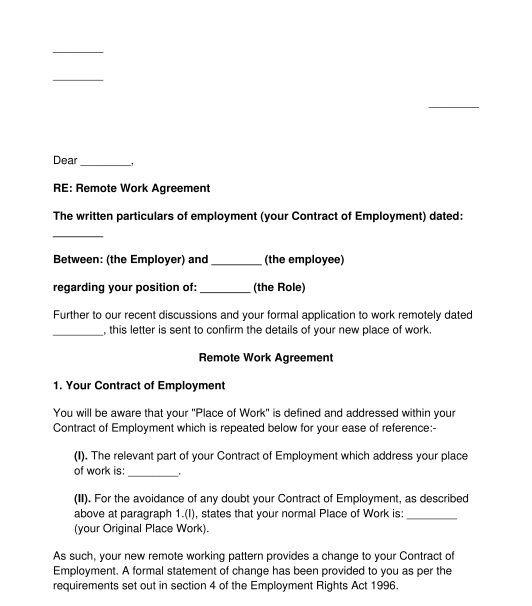
How does it work?
1. choose this template.
Start by clicking on "Fill out the template"
2. Complete the document
Answer a few questions and your document is created automatically.
3. Save - Print
Your document is ready! You will receive it in Word and PDF formats. You will be able to modify it.
Optional legal consultation
You can choose to get help from a lawyer after filling out the document.
Remote Work Agreement
Option: Help from a lawyer
What is a Remote Work Agreement?
A remote work agreement is an agreement that is used by an employer to set out the terms and conditions under which an employee will be permitted to work remotely . Remote work means that the employee is allowed to do their job from somewhere else other than the office (e.g. the employee's home, a coworking space, a cafe etc).
For example, an IT technician in a company may be granted the right to work remotelyand they will be required to sign a remote work agreement to show that they understand the conditions attached to their ability to work remotely and that they agree to those conditions.
Is it mandatory to have a Remote Work Agreement?
No , strictly speaking, it is not mandatory to have one. This is because the employer has no right to compel the employee to work remotely . However, if the employee will be permitted to work remotely or if the employer is making a change to the employee's working conditions to allow for remote working, then it is highly recommended to have a remote work arrangement. The remote work agreement will give clear guidelines on how the remote work arrangement should be, and set clear expectations of what is required of the employee.
What are the prerequisites of a Remote Work Agreement?
Before a remote work agreement is implemented, the employee should have submitted a flexible working request to their employer. The request will make it clear why the employee needs to work remotely and from when.
Where the remote work arrangement is initiated by the employer, the employer must have given the employee prior notice of why the remote work is being implemented. Similarly, the employment contract should either allow for this or be updated to reflect this change to the working conditions.
Who can enter into a Remote Work Agreement?
A remote work agreement should only be given to an employee within the organisation. This means that independent contractors (i.e. personnel working under consultancy agreements, service agreements or freeland agreements) do not need to be given remote work agreement. The contract between the independent contractor and the employer is what will govern how the contractor does their designated task.
The employer can also be any form of business structure such as a sole trader , a general partnership , an LLP or a limited company .
What can be the duration of a Remote Work Agreement?
The duration of the remote work agreement depends on needs of the employer or employee. It can be indefinite throughout the length of the employee's employment, or for a specific period of time .
What has to be done once a Remote Work Agreement is ready?
Once the remote work agreement has been drafted, it should be signed by both parties (i.e. the employer and the employee). Where the employer is a company, it should be signed by an authorised personnel (e.g. HR Manager). The employer can give a physical copy to the employee or sent it to their email address for their records. The employer should also keep a copy on file for themselves.
Which documents should be attached to a Remote Work Agreement?
The employee's flexible working request can be attached to the remote work agreement.
The employment agreement can also be attached to the remote work agreement.
The employer's work from home policy can also be attached to the remote work agreement.
Is it necessary to have witnesses for a Remote Work Agreement?
No , it is not necessary to have witness for a remote work agreement.
What must a Remote Work Agreement contain?
A remote work agreement must contain :
- The date when remote work will begin;
- The employee's working schedule while working remotely; and
- Any changes to the employment contract .
Which laws are applicable to a Remote Work Agreement?
The key piece of law which is relevant to remote working in England, Wales and Scotland is the Employment Rights Act 1996 .
The key piece of law which is relevant to remote working in Northern Ireland is the Employment Rights (Northern Ireland) Order 1996
Help from a lawyer
You can choose to consult a lawyer if you need help.
The lawyer can answer your questions or help you through the process. You will be offered this option when you complete the document.
How to modify the template?
You fill out a form. The document is created before your eyes as you respond to the questions.
At the end, you receive it in Word and PDF formats. You can modify it and reuse it.
Guides to help you
- How to Organize Remote Working for your Employees
- Signing Documents in England and Wales
Remote Work Agreement - Sample, template - Word and PDF
Country: United Kingdom
Employment Contracts - Other downloadable templates of legal documents
- Employment Contract
- Casual Worker Agreement
- Other downloadable templates of legal documents

Legal and practical tips for employers on homeworking
This month on 19 May it is “National work from home day”. So what should employers be aware of if they want to facilitate homeworking? Akshay Choudhry of Burges Salmon LLP examines the legal and practical considerations.
National work from home day is organised by Work Wise UK, a not-for-profit organisation aimed at making the UK a more progressive economy by encouraging smarter working practices. Cutting out the commute by allowing people to work from home can be a win-win; offering opportunities for the employer to reduce/reallocate office space and, for the worker, the benefit of valuable time-savings.
According to the Office for National Statistics, 13.9% of the UK’s workforce were homeworkers in January to March 2014, up from 11.1% in 1998, and the proportion of the UK workforce working from home is likely to rise as employers increasingly recognise that flexible working, including homeworking, can bring benefits to their organisation.
More on homeworking
Line manager briefing: homeworking
Homeworking policy
Homeworking agreement
How to manage homeworkers
Good practice: flexible working
Homeworking may mean working exclusively from home, but the term “homeworker” can also be used to describe those who divide their working time between home and their employers’ premises, work at home on an occasional basis, or are mobile workers who use their home as an administrative base. Whatever the precise arrangement, there are a number of issues for an employer to consider.
Changes to employment contracts
It will normally be appropriate to tailor a standard employment contract in order to reflect any homeworking arrangements. In some instances, it may also be sensible to put in place specific policies to cover off some of the more practical arrangements.
Particular changes to the contract to consider include the following:
Place of work – if the employee will be predominantly working from home, the normal place of work will be the employee’s home, although the contract should also include a provision that the employee can be required to attend the office as necessary. There should also be a provision for what happens if the employee moves house – particularly if the move is further away from the office which may have financial implications for the employer (see “expenses” below).
Hours of work – specify when the employee will need to be available for work. For example, will the employee be required to observe strict office hours, have complete flexibility over when they work, or have certain “core hours” when they must be available. Will they be required to account for their time and if so, how?
Salary and benefits – you should take care that homeworkers are not treated less favourably on grounds of any protected characteristic. For example, if an individual is working from home because of ill-health and receives less favourable benefits than a comparable office-based employee, they may claim disability discrimination. Ensure, for example, that they have access to work related benefits (such as the staff canteen or workplace gym) even though they may not use them regularly.
Expenses – consider whether or not employees will be entitled to expenses for travel to the office or a contribution towards telephone, broadband, heating and lighting costs. Other expenses to consider include postal/courier costs, stationery costs and photocopying/printing costs. If certain conditions are met, payments by employers to reimburse employees for reasonable additional costs incurred as a result of homeworking can be tax exempt.
Confidentiality and data protection – this can be difficult to supervise remotely so include an express term to address what is considered confidential information and the necessary protections required (such as passwords, encryption, a secure filing cabinet, a shredder etc) and make sure data protection obligations are maintained. If the employee is using their own computer/phone ensure you have a right to monitor work communications on those devices.
Equipment – will the employee require specific equipment to perform their work? If so, who will provide and pay for this equipment and who is permitted to access it? Will the equipment need to be insured and, if so, whose responsibility will it be to arrange and pay for this?
Right to enter – do you want include a licence to enter the employee’s home (on reasonable notice) in order to install, maintain or service any company equipment, or retrieve it on termination? A right to enter may also help enable you to carry out risk assessments for health and safety purposes, although legal advice in terms of enforcing this right would be needed if the employee (or another person) was refusing entry.
Trial period – consider allowing the homeworking for a trial period, and include this in the contract, so you can assess whether or not the arrangement will work in the longer term. It is also worth including the right to require the employee to revert to office-based working.
There are also practical considerations to consider when agreeing to a homeworking arrangement.
Health and Safety
An employer is responsible for an employee’s health, safety and welfare so far as is reasonably practicable. This means that employers must conduct risk assessments of all the work activities carried out by employees, including those working from home.
Whilst most homeworkers will be doing low risk, desk-based jobs, you should ensure appropriate risk assessments are conducted both at the start of the homeworking arrangement and periodically thereafter. Consider how you might regulate stress levels, how to ensure rest breaks and other working time obligations will be met, whether specialist equipment is required or needs to be safety tested, first aid arrangements, and reporting work-related accidents. The Health and Safety Executive provides useful guidance regarding homeworking.
Generally speaking, there is no legal obligation on an employer to provide the equipment necessary for homeworking. However, it is advisable to consider this on a case-by-case basis – particularly where the employee may suffer from a disability and the provision of such equipment could be considered a reasonable adjustment.
Most employers will provide basic equipment at least. For example, most will want homeworkers to use only company computer equipment to ensure compatibility as well as maintenance of virus protection and other security measures. It may also be sensible to provide the homeworker with a dedicated telephone line.
If the employee will be using their own computer equipment, agree whether or not the employer should pay for its maintenance, repair and fair wear and tear.
Data protection and security
Carry out a risk assessment of the data protection implications of homeworking. This would include consideration of the following:
- Who might have access to the employee’s computer?
- Is the employee’s home adequately secure?
- What rules do you have regarding encryption, use of passwords, and the transfer of data between home and office?
- What rules do you have in place regarding the retention of data?
- What measures should be taken against accidental loss, destruction or damage?
Reporting and performance reviews
Out of sight should not mean out of mind. Adapting your reporting and review procedures, as well as individual management styles, will be important both for the homeworker – who may otherwise feel isolated and without support – and the employer – as you will need to monitor the quality and/or quantity of the homeworker’s output and retain the relevant level of control over the relationship.
Consider formalising the contact that homeworkers should have with their manager (for example being required to report in at least once per day/week). You could also require homeworkers to attend the office for regular meetings.
Public liability insurance
Check your employer’s liability insurance covers employees working from home. Make sure your actions (or any lack of action) don’t invalidate the insurance.
Mortgage provider consent
Remind the homeworker that they must have consent from their mortgage provider to work from home.
The mere fact that an employee is working from home should not change their tax status – you should still deduct income tax and national insurance contributions as normal.
However, you may advise the employee:
- to check any potential council tax liability as a result of homeworking;
- that some of their homeworking expenses may be tax deductible;
- that, in limited circumstances, they may be entitled to a tax deduction in respect of the expenses of travelling from home to the office; and
- if computer equipment provided by the employer is used for anything more than “insignificant” private use, a tax charge may arise.
Working time
Sign up to our weekly round-up of hr news and guidance.
Receive the Personnel Today Direct e-newsletter every Wednesday

Normally, time spent by an employee travelling to their place of work would not count as “working time” under the Working Time Regulations 1998. However, where the employee’s normal place of work is their home and they travel to their employer’s premises or to see clients/customers, this could count as “working time”. You will need to ensure that homeworkers do not exceed the 48-hour limit on their working week when travel is taken into account (or that they have opted out of the maximum hours’ cap).
The war for talent is alive and well and people are demanding to work differently. With employees increasingly welcoming the opportunity to work from home, employers that are able to offer this should reap the rewards from this competitive advantage.
Akshay Choudhry
Akshay Choudhry is an associate at Burges Salmon LLP .
The future of HR: Embrace technology, but stay human
Cipd manifesto urges next government to make “good work” a priority.
These are very useful tips and information, Akshay! Thank you!
Leave a Comment Cancel Reply
Save my name, email, and website in this browser for the next time I comment.
You may also like
Amazon orders full-time office return, business secretary defends employment rights bill, worker reforms threat to uk business, say firms, school agrees to pay £850k to teacher with..., campaigners call for afro hair to become protected..., e-bike boss constructively dismissed over fire safety fears, supreme court: tesco workers triumph in fire and..., ‘emotional’ pregnant mitie manager wins £350k in compensation..., bolt drivers launch worker status claim, businesses ‘less likely to hire’ after workers’ rights....
Press ESC to close

An Employer’s Guide to Homeworking Policy
The years 202o and 2021 saw a dramatic increase in homeworking due to COVID – 19. Homeworking is a valuable tool for the employer and also employees.
This is an effective home working guide for employers.
What is Homeworking?
Homeworking is a form of flexible working policy that involves the use of technology to enable employees/home workers to work away from the employer’s office. In this system, employees can either be mobile, based at home, or work from home occasionally. Homeworking has benefits to the employers but it requires policies and procedures to run smoothly and that is what this guide is about.
Types of Homeworking
Occasional homeworking.
This type of homeworking is frequent and is done on an ad-hoc basis. This can happen when there is a specific task the employee needs to do that requires concentration without regular office interruptions. This can also occur in cases of illness or adverse weather conditions. To authorize such a request the needs of the company has to be considered.
Regular Homeworking
Regular homeworking is an agreement where the employee or home worker spends more than fifty percent of their contracted time working from home. The regular homeworker is to meet certain targets that have been agreed upon with the employer. To become a regular homeworker the employee has to put in a formal request to the employer. This formal response has to be reviewed and carefully considered by the employer or HR.
Permanent Homeworking
For this type of work, the employee spends a hundred percent of their time working from home. This also includes employees that permanently visit sites from their home base. This should be included in the employee contract. This kind of contract works best where the employee has an autonomous job. A formal request has to be filed before a permanent homeworking contract can be granted.
Benefits of Having Homeworkers for the Employer
Homeworking increases productivity.
Working from home helps the homeworker to avoid the possible distractions that can occur in the office. This improves output and increases productivity. It can also improve the quality of work of homeworkers who value working from home as their work-life balance is improved. This can also lead to a greater commitment from homeworkers.
Homeworking Reduces Overhead
Having homeworkers can reduce overhead costs. If employees work from home, less office space will be used. This will, in turn, lead to a reduction in rent, utility bill and business rates. Also, if the business is expanding and needs more space it may be cost-effective to have where possible some employees work from home in order to create more space.
Homeworking for More Diverse Workforces
Having a flexible system where employees can work from home means that the firm will be able to capture a diverse group of employees. Disabled people for example or a mother will be able to get involved. This means that your firm is open to more ideas and talents. Each individual has their unique way of doing things and this may help the company grow.
Improvement in Company Reputation
Having a reputation for flexibility might be a plus and be attractive to talented employees. Having this reputation may also help attract more customers to your firm as well as stakeholders. There are benefits to being seen as a flexible firm and it may help with word-of-mouth advertisement.
Flexibility
Having a rigid system means that you are restricted to a particular region and territory. But with a flexible system, you do not have to consider geography as you can employ bright minds in a completely different country or continent. The flexibility of home working also helps you retain current employees. If for example, an employee has to move they can continue working for the company.
Reduced Carbon Emissions
Employees having to show up at work every day means that they contribute daily to pollution in society. Allowing some employees to work from home may be a way of showing that you care about the environment by reducing the number of pollution employees cause daily through commuting.
Some Possible Pitfalls of Homeworking
It is important to know the possible things to consider so you watch out for them and deal with them properly.
Separating home life from work life may be hard for the homeworker
The homeworker may easily let their work-life take over their home life and this can begin to affect their wellbeing. It may be necessary to produce a working guide for the employee or give regular breaks. It is also important to regularly check on the homeworkers.
Homeworker management
For homeworking to function effectively there has to be proper management in place. This is more demanding than it would have been in an office building. There has to be greater trust between the homeworker and management. Also, effective communication tools should be set up for easy communication between the homeworker and the manager.
Homeworking costs
There may be some initial cost for setting up homeworking. This might include the cost of setting up communication tools, video calls but this initial cost will eventually even out with the cost saved from overheads due to reduced staff in the office. So, the savings may be greater in the long run for the company.
Access to employee representatives
Even though employees are working from home they still need to be able to communicate with their representatives i.e. trade union. As an employer, you should take reasonable steps for this to happen. You can have a space in the office for employees to meet with their representatives for example.
Homeworkers as carers
When a homeworker is also a carer you have to ensure that they know work time should not be used for caring for dependents. You should inform them that they are to create alternative arrangements for their dependents to be looked after by someone else during work time. This should be arranged before the employee becomes a homeworker.
The Legal Issues Around Homeworking

Health and safety of the homeworker
The health and safety requirements apply to homeworkers; therefore, you owe your homeworkers a duty of care. As an employer, you have to conduct an appropriate risk assessment to ensure that the ventilation, lighting, chair, table, computer, or any other work essentials in the proposed workplace is suitable for the work needed to be done.
This risk assessment must be carried out with the proposed homeworker’s task in mind. You are required to supply the employee with essential equipment. If there is any dysfunction to be rectified after the home assessment, it is the role of the employee to rectify this. It is also the role of the homeworker to keep the workplace safe after it has passed the risk assessment and they are required to inform you of any change in the workplace.
Handling an employee’s flexible working request
Employees with 26 weeks of service can request to work flexibly. You are not obligated to accept such a request but there has to be a reasonable reason for refusing it. You have to properly communicate and explain this reason to the employee. The law sets out eight possible reasons for refusal:
- It will place a burden of additional costs on the firm
- It will have a detrimental effect on the company’s ability to meet its customer’s demands
- The company is unable to reorganize work among its current employees
- The company is unable to take on new employees
- Homeworking will affect the quality of work produced
- It will affect the performance of the employee
- There is insufficient work during the employee’s proposed work period
- There are planned structural changes
Supervision and support of homeworkers
A homeworker is still subject to the same support and supervision given to an on-site worker. There should be regular daily appraisals with the supervisor. The supervisor should also be quick to pick up on signs of stress or difficulty and it should be dealt with immediately. The appraisal, reporting, and support system should be agreed on from the onset. There should also be enough opportunity for the homeworker’s work to be reviewed and a system in place to track the progress of the homeworker. If a homeworker complains that their health is being affected this should be raised immediately and the homeworker referred to appropriate care. As well as a risk assessment it may also be important to carry out a stress risk assessment and issues raised should be addressed.
Confidentiality and data security
Data security obligations do not change simply because an employee is now a homeworker. Regardless of the location, work is carried out by the employer and the employee is still; bound by GDPR and other data security laws. The homeworker must be reminded of this. It is also important to assess equipment provided to homeworkers during a risk assessment to see if they comply with data protection laws.
The tax status of an employee does not change simply because they are now a homeworker. The income tax and national insurance contribution should still be removed from the employee’s salary. It is important to inform your employees about the possible tax implications involved with homeworking. In the course of carrying out their job, the homeworker may need to purchase additional equipment. You can pay tax-free payments to employees to cover the additional cost involved with homeworking.
Working time
Under the Working Time Regulations 1998, the time an employee spends commuting to work does not count as working time. However, for a homeworker, the time spent commuting to the employer’s premises counts as working time. It is important to agree on the working times with the homeworker from the onset. It should be agreed if it will be a strict working time or flexible. If it is flexible core hours should be agreed and if it is fixed then breaks should be agreed on. This will help you ensure your employees are not overworking. Whilst agreeing on the working time it is important to ensure that homeworkers do not exceed the 48-hour limit on their working week and remember the traveling time adds to this. The only exception is if they have opted out of the maximum hours’ limit.
Mortgage provider
There is some mortgage agreement that prohibits the use of the property for business purposes without consent. It is important to remind employees to check their lease and obtain consent from their mortgage provider to work from home where stated. The homeworker should also get confirmation of cover from their home insurer in case a piece of work equipment causes damage. It should also be agreed from the onset if you will cover the extra premium.
Is Homeworking the Right Choice for Your Organization?
One effect of COVID-19 is the increase in homeworking. This type of flexibility has many benefits to the employer. It reduces cost, increases the quality and quantity of work, gives the company a good reputation, and gives the employer a wider range of choices. Before deciding to allow home working, it is important to consider the initial cost involved, if you can manage employees from home, how to give homeworkers access to their representative and how to handle a homeworker that is also a carer.
You should also be aware of the legal issues involved such as data security, health and safety of homeworkers, support of homeworkers, and basic things that should be agreed on from the outset. With the advancement of technology and the flexibility the 21 st century brings, homeworking is definitely something to consider and implement where appropriate.
Share Article:
You might also like
Wage and Salary
TUPE – Transfer of Undertakings (Protection of Employment) Regulations
The Myers-Briggs Type Indicator (MBTI): A Comprehensive Review of the Personality Test that Is Sweeping the Nation
Other stories, an employer’s guide to flexible working in the uk, how to stay safe against wrongful termination suits.
7 things you should do when negotiating a work-from-home agreement with your boss — and 4 things to avoid, according to a negotiations expert and MBA professor
- Leigh Thompson is an author, a professor at Kellogg School of Management, and a negotiations expert.
- As offices reopen, many people who prefer to continue working from home will need to negotiate this with their employers.
- Thompson shares the most tactful ways to approach what is likely an unprecedented negotiation.

The news filled Lisa with dread.
A digital-marketing senior account manager, Lisa was nervous when she heard her employer was issuing a "back-to-work" order: everyone was to be back in the office by July.
The problem was that Lisa, my past student, had flourished during COVID. She'd transformed a utility closet into a state-of-the-art home office: external monitor, high-resolution camera, standing microphone.
Lisa also began her days hours earlier, interspersing meetings and client calls with "focused time" on creative solutions to multiple challenges. "My new mental sharpness has tripled my productivity," she said. She'd also enjoyed seeing her young children more often, and working out more regularly.
But now the dream seemed to be ending, as schools and camps reopened (no more childcare excuses for working parents) and management sought a return to business-as-usual. For example, Lisa mentioned a recent meeting where senior leaders talked about the importance of "hustling" — which they viewed as possible only in face-to-face work.
Lisa sought my guidance on negotiating a remote-work arrangement. The advice I gave, reflected in the do's and don'ts below, can serve you in similar, critical post-pandemic negotiations.
1. Write the script
Many negotiations follow a standard procedure: buying a home, negotiating compensation, others — "scripted" negotiations, where both parties know what to expect. But a remote-work negotiation is largely unscripted, with no unwritten rules. So, rather than "ambushing" your manager about working from home, do the homework to understand why the request makes sense (see Do Your Research below), then suggest meeting to go over things at the right time/place.
Related stories
2. go synchronous.
COVID made many formerly synchronous (real-time) things asynchronous, such as college classes. Similarly, it may be tempting to send your manager a long email about why you should work from home, in part to avoid face-to-face discussion. Instead, schedule a call or Zoom meeting. My research shows people behave more contentiously in asynchronous communications. Moreover, real-time communication enables you to read the room, react, and refine.
3. Frame the conversation
This is likely an unprecedented negotiation. So it's important to provide a "frame" for the conversation including: (1) plural pronouns ("We" not "me"); (2) emphasis on alignment ("It's about how I can maximize my productivity to help the company meet its goals"); (3) open-ended approach ("This is a starting point in a plan that will evolve").
4. Do your research
Nothing speaks louder than data. One manager presented her productivity by month, highlighting that her post-COVID performance was superior on every metric, bolstering her case for remote work. Also, consider what management cares about — it's probably not just money, so don't lead with "I'll take a 20% pay cut to work remotely."
5. Put skin in the game
The initial answer to your work-from-home pitch will likely be "no." Be prepared, and use the skin-in-the-game strategy from my book " Negotiating the Sweet Spot ": suggest working from home temporarily, and agree on performance metrics to hit to finalize the arrangement.
6. Plan your Plan B
Think carefully about options if work-from-home simply isn't possible. Talk to family members (and yourself) about the "what thens." It may mean returning to traditional work — long commute, slow elevators, and all — or submitting a thoughtful resignation letter and searching for remote-work opportunities. Knowing Plan B helps you pursue Plan A.
7. Do the hustle
Recent evidence suggests that when it comes to professional motivation, we judge a book by its cover — meaning, if someone's not physically present, they must lack "hustle." My work with Sarah Townsend on " personal work ethic " shows hustle is not about physical presence but the intrinsic motivation to work hard "when no one's looking." So hustle remotely and measure the results to prove it.
Don't do these:
1. don't assume opposition.
Most people assume others have interests diametrically opposed to theirs. This often yields a self-fulfilling prophecy approach: "I know this is probably not possible, but …" Instead, use the framing advice above: "My aim is to continue my high level of productivity as we move toward key organizational goals. I have some concrete ideas for how to do that."
2. Don't threaten
Any reference to your Plan B, no matter how subtle ("I have other options"), is a threat. The research suggests any threat leads to a power escalation and suboptimal outcome. Don't go there.
3. Don't play the pity card
Don't lead with emotion ("My children need me") because people generally don't respond well to negative emotions in negotiation. Instead, lead with perspective-taking; the best way to get them to see your perspective is to take theirs, which is likely about achieving company objectives efficiently.
4. Don't think in "Yes/No" terms
Best not to think of the conversation as leading to a yes-no outcome. Rather, pursue a "hot-warm-cold" conversation: come prepared to discuss your ideal scenario, but ready to present alternatives — such as hybrid work. In my book, I call this "bringing out the dessert tray." Often, success is piquing their interest in one or more options to be discussed in a subsequent meeting.
Lisa used much of the advice here to argue her case for remote work. She achieved a win-win where she will continue to work mostly remotely, delivering strong results for the company while enjoying a high level of autonomy. Harness the ideas here to negotiate your way to your own best-case scenario.
Leigh Thompson is a professor at Kellogg School of Management at Northwestern University and the author of the new book "Negotiating the Sweet Spot: The Art of Leaving Nothing on the Table."
Watch: This Facebook exec cofounded and then got fired from Pets.com. Here's why she is no longer hiding from this failure.
- Main content
7+ SAMPLE Work From Home Agreement in PDF
Work from home agreement, 7+ sample work from home agreement, what is a work from home agreement, important sections of work from home agreement, tips for employees who will have a wfh agreement, how to have a work from home agreement, can you define the work from home program, which is better to have a temporary or a permanent work from home agreement.
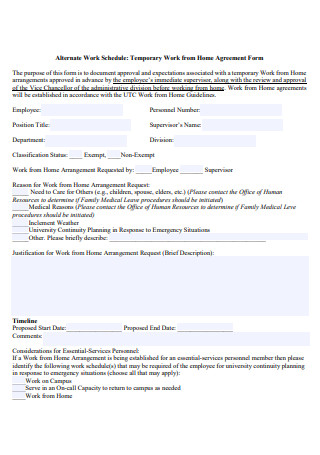
Work From Home Agreement Form
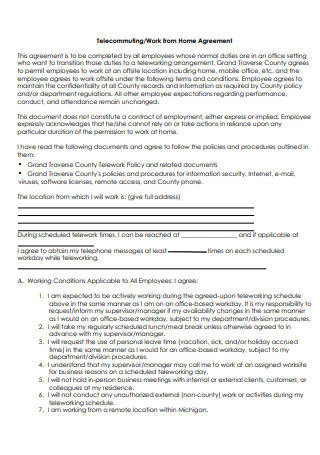
Basic Work From Home Agreement
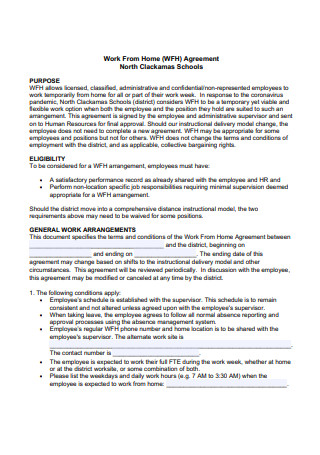
Work From Home Agreement Example
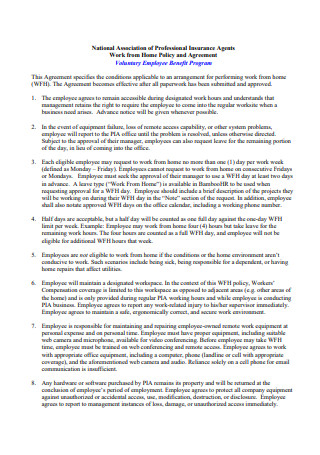
Work From Home Policy and Agreement
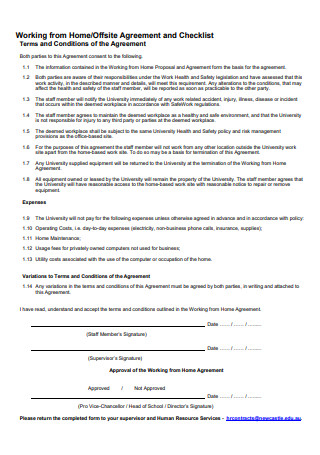
Working From Home Agreement and Checklist
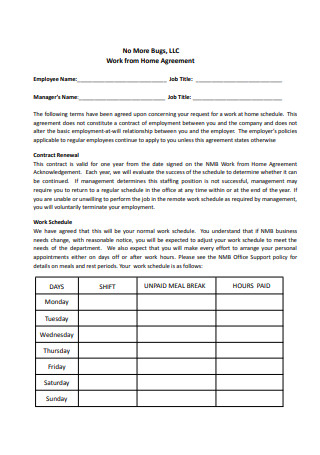
Sample Work From Home Agreement
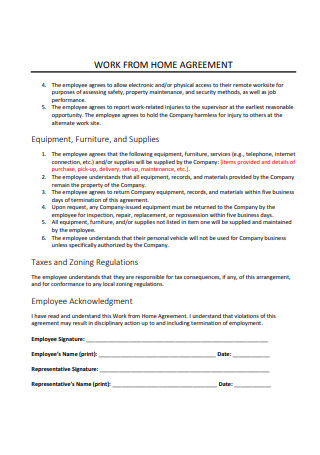
Work From Home Agreement in PDF
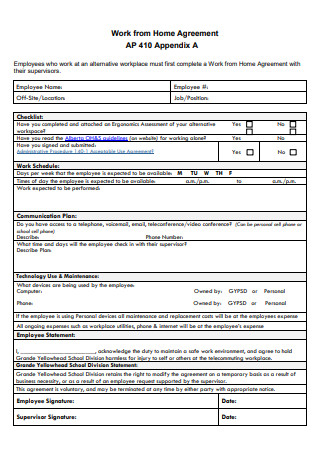
Formal Work From Home Agreement
Share this post on your network, you may also like these articles, 8+ sample car agreement in word | google docs | pdf | apple pages.

Welcome to the intersection of clarity and automotive transactions! Our Car sample Agreement examples set the gold standard for precision and transparency. In this comprehensive collection, dive into a…
10+ SAMPLE Property Agreement in PDF | Word | Google Docs | Apple Pages

Welcome to the pinnacle of property transaction efficiency! Our Property Sample Agreement document is your key to navigating the intricacies of real estate with ease. Tailored for the United…
browse by categories
- Questionnaire
- Description
- Reconciliation
- Certificate
- Spreadsheet
Information
- privacy policy
- Terms & Conditions
- Practical Law
Homeworker and hybrid worker clauses
Practical law uk standard clause 5-202-1606 (approx. 18 pages), get full access to this document with a free trial.
Try free and see for yourself how Practical Law resources can improve productivity, efficiency and response times.
About Practical Law
This document is from Thomson Reuters Practical Law, the legal know-how that goes beyond primary law and traditional legal research to give lawyers a better starting point. We provide standard documents, checklists, legal updates, how-to guides, and more.
650+ full-time experienced lawyer editors globally create and maintain timely, reliable and accurate resources across all major practice areas.
83% of customers are highly satisfied with Practical Law and would recommend to a colleague.
81% of customers agree that Practical Law saves them time.
- Design policies and processes
- Legal operations, technology and people management: practice management
- Managing ethics and culture
- Atypical Working
All Formats
Table of Contents
Agreement template bundle, 11+ work from home agreement templates in pdf | ms word | google docs, 1. work from home agreement template, 2. covid-19 working from home agreement, 3. work at home agreement template, 4. temporary remote work agreement template, 5. flexible work arrangement form template, 6. non-faculty work at home agreement, 7. work from home agreement example, 8. work at home agreement in pdf, 9. working from home health and safety agreement, 10. sample work from home agreement template, 11. work from home approval agreement form, 12. alternative work from home agreement template, what is a work from home agreement, how to write a work from home agreement, what is a disadvantage when it comes to working from home, what equipment would i need in order to work from home, what are some of the benefits of working from home, what is the negative effect of working from home, hr templates & forms.
- FREE 11+ Work From Home Agreement Templates in PDF | MS Word | Google Docs
Nowadays, working from home has become one of the biggest conveniences an employee can ever opt to do. With this kind of option however there comes a lot of issues. Employees can take advantage of being able to work without supervision at home. One way to make sure this doesn’t go off the rails is to have them sign a work from home policy agreement. With it they are obligated to stick with the rules and regulations of the workplace even if they are not there in person.

- Google Docs
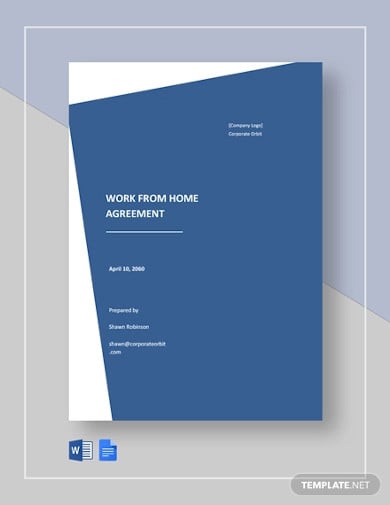
1. Word Out the Agreement Properly
2. specify the requirements, 3. discuss compensation and benefits, 4. use an organized format and proofread, more in hr templates & forms.
Report Work Instruction Template
Lab manual work instruction template, journal work instruction template, junior work instruction template, instruction guide template, work instruction manual template, lean work instruction template, blank work instruction template, iso 9001 work instruction template, quality work instruction template.
- FREE 12+ Covid-19 Unemployment Templates in PDF | MS Word | Google Docs
- FREE 25+ Work From Home Templates in PDF | MS Word | Google Docs
- FREE 8+ Work From Home Checklist Templates in PDF | MS Word | Google Docs
- FREE 11+ Work From Home Schedule Templates in PDF | MS Word | Google Docs
- FREE 10+ Work From Home Application Form Templates in PDF | MS Word
- FREE 10+ Work From Home Proposal Templates in PDF | MS Word | Google Docs
- FREE 11+ Work From Home Policy Templates in PDF | MS Word | Google Docs
- 26+ HR Welcome Letter Templates – DOC, PDF
- 18+ Sample HR Appraisal Forms – PDF, DOC
- 13+ HR Recruiter Job Description Templates in PDF | MS Word
- 32+ Employee Record Templates in Word | Apple Pages | Google Docs | PDF | Outlook
- 10+ Onboarding Plan Templates in Google Docs | PDF | Word | Pages
- 10+ New Hire Onboarding Checklist Templates in Excel | Numbers | Word | Google Docs | Pages | PDF
- 19+ HR Invitation Letter Templates – PDF, DOC
File Formats
Word templates, google docs templates, excel templates, powerpoint templates, google sheets templates, google slides templates, pdf templates, publisher templates, psd templates, indesign templates, illustrator templates, pages templates, keynote templates, numbers templates, outlook templates.

Home and hybrid working: current employment law essentials for people professionals
What do HR practitioners need to know and do regarding contractual issues and health and safety law?
The CIPD has supported the people profession and employers in their response to COVID-19 since March 2020 and continues to do so by providing a raft of up-to-date guides and resources. CIPD provision includes supporting returning furloughed workers and planning employees’ return to the workplace . Several of our guides focus on aspects of employment law, such as our guide on flexible working measures for returning to the workplace .
This article sets out the main aspects of contracts and health and safety law. It includes what these mean for HR practitioners as they continue to play a pivotal role at the forefront of organisations still navigating their way through the pandemic. Being proactive in the main legal and employer dimensions of home and hybrid working right now will help promote good work and pre-empt litigation.
Home and hybrid working to continue for many employees
The sudden shift to home working for a large proportion of the workforce in the UK was a hallmark of the initial employer reaction to the prevalence of coronavirus. It is now anticipated that, for over a million people , home working is likely to stay to some extent, with the number of hybrid workers expected to increase correspondingly.
Hybrid workers are those who spend part of their time at their workplace and part of their time working from another location, such as their home. Our research on hybrid working indicates that the majority of employees want to keep working from home at least some of the time and will therefore benefit from CIPD tools , guides and a webinar on hybrid working. Our line manager guide on supporting hybrid working is especially helpful for HR practitioners and HR business partners in their collaboration with line managers responsible for hybrid working employees.
Employers using home or hybrid working arrangements need to act on a range of law-related aspects. These include:
- reviewing existing HR policies, for example homeworking or flexible working policies, and introducing new ones, such as a hybrid/agile working policy
- organising how workers will be managed and supervised, while ensuring no differential treatment
- incorporating new contractual clauses into employment contracts
- checking whether any employer’s liability insurance policies need updating
- identifying how confidential company, employee and client information will be kept secure, and
- identifying any employee tax implications, such as expenses incurred in working at home or for computer equipment provided.
Contractual issues in home or hybrid working requests and practices
Contractual issues are at the centre of planning and operating home or hybrid working, starting with flexible work.
There is currently a statutory framework for employees to make formal requests for a flexible working arrangement. However, new research reveals that nearly half of employees do not have flexible working in their current role despite the shift to home working, which sparked the CIPD’s recently launched campaign on making flexible working requests a day-one right .
Although any alteration to a working arrangement specified in an employment contract will generally be a material change to terms and conditions of employment, home or hybrid working may be agreed on an informal basis without the need to formally alter an employment contract. This may be as part of a flexible or agile working policy which allows an employee to choose whether, and when, to work from home and in the workplace, subject to business requirements.
Employers should ensure that they adopt consistent HR policies and practices for all employees in flexible working. This might be by requiring employees to make a formal request to amend their contract, or by implementing a policy of discretionary hybrid working for all or part of the workforce, for example.
An employer that opts for home or hybrid working to operate on a non-contractual, discretionary basis should be aware that the working arrangement may, depending on its nature, become an implied term of the employment contract over time. If it becomes a common and accepted practice, employees can argue they have a ‘custom and practice’ contractual right, should their employer decide to roll back on home or hybrid working.
Further contractual issues to consider
- Employers who change the written statement of particulars of employment are required to give workers a written statement containing the particulars of that change. For example, if there is a contractual change to working location, this should be provided to employees in writing.
- A change to working location may be imposed on employees when an employer decides to give up or reduce their organisational workspace. If this occurs, some employees may not agree with such an attempt to unilaterally vary their employment contract. This would potentially be a breach of contract and could also lead to a claim of constructive dismissal or unfair dismissal by the employee. HR practitioners are therefore advised to communicate and consult with employees on a proposed change to working location to get their agreement.
- Employers seeking to rely on a flexibility clause, such as a mobility clause, to make any such alteration should be aware that case law has interpreted these clauses narrowly. Flexibility clauses cannot be relied on unless the alteration is construed as reasonable or a minor administrative change which is not detrimental to the employee.
- Where home or hybrid working becomes a more permanent arrangement, consideration may need to be given to amending other contractual terms. This may include hours of work, salary and benefits, any expenses which can be claimed, and how confidentiality and data protection will be maintained.
- Employers should take care to ensure that homeworkers do not experience less favourable treatment compared with other employees. Consideration should also be given to the Equality Act 2010, and ensuring that any decisions about hybrid working are not discriminatory on the grounds of a particular protected characteristic.Where an employee has a disability, homeworking might be a reasonable adjustment but, in some circumstances, this could cause additional disadvantage. Therefore any impact on a given individual should be considered by HR practitioners. Inclusion and fairness are paramount.
- An employer’s HR policies and procedures, including normal disciplinary and grievance procedures, apply to home and hybrid workers in the same way as to other employees. HR practitioners therefore need to ensure consistent application of all policies.
Health and safety law applicable to home workers
Employers must be mindful of their duty of care to home workers. Employers have a duty under the Health and Safety at Work Act 1974 to ensure the health, safety and welfare of employees as far as is reasonably practicable. If an employer employs more than five people, it has a statutory duty to have a written statement setting out its general health and safety policy.
HR practitioners will often have had a responsibility in managing health and safety considerations during COVID-19. Health and safety duties apply equally to home workers as to other employees, a point which can be overlooked by organisations. Therefore risk assessments of employees’ home workstations are required.
A failure to comply with health and safety measures could be considered a breach of the mutual duty of trust and confidence under the employment contract, and reporting a health and safety breach may be a protected disclosure. HR practitioners should be aware that there may be an increase in claims on whistleblowing or constructive dismissal in relation to health and safety. Employers’ duties include a duty to consult with employees on health and safety matters, which includes measures in response to COVID-19.
HR practitioners have a very important role in considering the main aspects of statutory employment law for home and hybrid workers. Good employers will be actioning these aspects now. Employers who aren’t are more likely to face cases brought against them at an employment tribunal. Time will tell.
This autumn, government figures will be published on the number and type of cases that were raised by employees in the year 01 April 2020-31 March 2021 - a main part of the pandemic period. However, it is in the figures for the year 01 April 2021-March 2022 that we are most likely to see the total number of cases related to the issues outlined in this article.
Ministry of Justice employment tribunal application figures for England, Scotland and Wales
| Year (01 April - 31 March) | Employment tribunal applications made |
|---|---|
| 2017/18 | 109685 |
| 2018/19 | 121111 |
| 2019/20 | 103984 (published in September 2020) |
Source: www.morton-fraser.com/knowledge-hub/employment-tribunal-award-statistics
Our Work-from-Anywhere Future ’, Harvard Business Review
‘ Working from Home during the COVID-19 Lockdown: Changing preferences and the future of work ’, University of Birmingham
Browse our A–Z catalogue of information, guidance and resources covering all aspects of people practice.
Bullying and harassment
Discover our practice guidance and recommendations to tackle bullying and harassment in the workplace.

17 Sept, 2024
11 Jul, 2024
3 Jul, 2024

A Northern Ireland summary of the CIPD Good Work Index 2024 survey report
More thought leadership

In the context of heightened sensitivity and media rhetoric, we examine recent data from employers to understand the trajectory of the future of EDI

How can people teams balance line managers’ need for operational people management support while growing their team’s strategic influence through the HRBP role?

We examine and outline recent research investigating the impact of generative AI tools on the HR profession

Monthly round-up of changes in employment law in the UK
CIPD Update
Get the latest insights on the world of work. CIPD Update includes UK and global news and events.
You can also sign up for updates from our teams in Ireland , Asia , and the Middle East .
You can unsubscribe or change your marketing preferences at any time by visiting our Marketing Preference Centre . By submitting this form you confirm that you have read our privacy policy and terms and conditions .
How to Negotiate Remote and Flexible Work Arrangements with Your Boss
by Ruchi Sinha and Carol T. Kulik

Summary .
As social distancing restrictions are slowly lifting in many parts of the world, many who have been working from home are feeling anxious about returning to the office.
- Those who are uncomfortable may consider negotiating flexible work arrangements with their employer.
- Here are four tips for making the ask.
In response to restrictions due to Covid-19, businesses and companies have adopted flexible work arrangements on a grand scale. Employees who never thought of working from home before are experiencing a newfound love for the flexibility that remote work can offer.
Partner Center
- How Can We Help?
- 0330 912 8338

23 January 2023 | HR & Employment
Homeworking Policy – Options as an Employer or Employee

This Insight is #9 in our Employment Handbook series, keep an eye out for more.
Homeworking Policy
Homeworking is a type of flexible working which, depending on the agreement between employer and employee, can be also used in conjunction with other arrangements such as flexible hours, working part-time, term-time working or the employer’s core hours.
Homeworking can be a great way to fit work around other commitments, such as childcare or caring for elderly relatives. It can also be used to reduce commuting time and costs.
A working from home policy clarifies the expectations and procedures for employees who wish to work from home. It is important to have such a policy in place so that there is a clear understanding of the company’s expectations and procedures regarding homeworking.
As an Employer, you have the option of incorporating homeworking as part of a flexible or hybrid policy, whereby employees are still required to come into the office on set days of the week.
Alternatively, you might be content with permitting your employees to work from home on a full-time basis.
Working from home: Benefits to Employers
Having employees who work from home permanently can be a great benefit to employers.
These benefits include:
- Employees based in different geographical areas which means organisations can recruit from a wider area.
- Saves costs of expensive commercial premises as they can have fewer or smaller premises.
- Helps protect business continuity as the business can be spread over different locations, rather than being focused in one location.
Working from Home: Benefits to Employees
Not only do employers reap the benefits of staff working from home, but employees do too:
- The arrangement allows employees to work for an employer outside the geographical area they’d normally be forced to work in.
- They are able to avoid the daily commute.
- Provides greater flexibility to the UK staff member.
Will working from home continue after Covid-19?
There have always been employers with homeworkers but, due to the COVID-19 pandemic, homeworking has become the norm rather than the exception.
During the pandemic many employers were compelled to allow staff to work from home in accordance with government guidance, forcing a shift in approach to homeworking for many businesses, and so it is likely that homeworking will become more common in the future, whether as a full-time arrangement or as part of a hybrid working pattern.
Homeworking Legalities for Employers & Employees
Any employee who is recruited on the basis that they’ll work from home will need to have this fact set out in their contract of employment.
If an employee wants to change their working arrangement so that they can work from home, they’ll need an agreement with their employer as it’s not an automatic right in the UK for employees to work from home. It’s then up to the employer to decide whether they’re going to allow the change.
If the employee has been with the company for at least 26 weeks, they can ask to work from home as part of a flexible working request. In that case, the employer is required to follow the statutory procedure for dealing with flexible working requests.
If the change is agreed to, the employer needs to change the employee’s contract so that it reflects the new arrangements.
In addition to ensuring the individual contract is amended, employers should also have a Homeworking Policy.
What Should the Homeworking Policy Include?
A homework policy in the UK should set out the rules around homeworking and explain what is expected of those working from home so that expectations are in alignment.
The policy needs to include:
- Whether the arrangement is temporary or permanent.
- There is a trial period and how long that will be.
- The locations the employee can work from.
- The expectations of an employee working from home.
- When they’ll need to come into the workplace.
- What equipment the employer will supply for homeworking.
- Data security considerations.
- How the employer can end the arrangement if needs be.
- Health and safety requirements.
This last point is an important one that’s often overlooked, as the employee’s home becomes an extension of their workplace. This means that the employer can be held liable for any accidents the employee has at home while they’re working.
As a matter of law, employers must provide employees with employment contracts that cover the key terms of their employment relationship. However, it is also good practice to have non-contractual policies and procedures in place, such as an employee handbook. This can sit alongside contracts of employment to set out how employees are expected to act and can help prevent or resolve disputes between employees and employers.
Your responsibility as an Employer
As a matter of law employers must give employees employment contracts which cover the key terms of the employment relationship, but the contract won’t cover all of the policies, procedures and expectations for the relationship between a business and the people within it. A employee handbook can include information for all team members, including employees, workers, apprentices and agency staff. Not only can a employee handbook bring together useful guidance for everyone on the culture, values and expectations the business as but it will often be a resource that can save a dispute from arising or provide the best framework for resolving a dispute. The non-contractual policies and procedures that can be included in a employee handbook will sit alongside contracts of employment to set out how employees are expected to act and how the employer will deal with certain situations.
Putting all the policies and procedures together in one place that is accessible to everyone working in a business is good practice and can provide an invaluable framework for reference on all of the HR issues to cover. If any grievance or dispute arises, having a policy or procedure to refer to and follow can help prevent the situation escalating. If the worst occurs and a claim comes before a tribunal, being able to show the policies and procedures that were followed can make a huge difference to the outcome.
Homeworking has become the norm for many businesses all over the UK. If that’s the case for you, you’ll need a policy in your Employee Handbook for it. For more information about Homeworking Policies get in touch with our Employment Law team on 0330 912 8338 .
Need Legal Advice? Call 0330 912 8338 for a no-obligation chat with one our experts today.
Where to find us

Adrian Green
Related expertise.
Please note this article is provided for general information purposes only to clients and friends of Atkins Dellow LLP. It is not intended to impart legal advice on any matter. Specialist advice should be taken in relation to specific circumstances. Whilst we endeavour to ensure that the information in this article is correct, no warranty, express or implied, is given as to its accuracy, and Atkins Dellow LLP does not accept any liability for error or omission.
© Atkins Dellow LLP 2024
More Insights

Anti-facilitation of Tax Evasion Policies in Employment Law
06 August 2024 | HR & Employment
Introduction to Anti-facilitation of tax evasion policy As a matter of law employers must give their employees a written document which covers the key terms of the employment relationship. On top of this, it’s good practice for employers to have a staff handbook which...

Menopause Policies in Employment Law
29 July 2024 | HR & Employment
Introduction to Menopause Policy As a matter of law employers must give their employees a written document which covers the key terms of the employment relationship. On top of this, it’s good practice for employers to have a staff handbook which includes the...

Bring Your Own Device to Work Policy for Employers
22 July 2024 | HR & Employment
Introduction to Bring Your Own Device to Work Policy As a matter of law employers must give their employees a written document which covers the key terms of the employment relationship. On top of this, it’s good practice for employers to have a staff handbook which...
We’re here to help
Privacy overview.

Working from home and hybrid working
Hybrid working is a type of flexible working where an employee splits their time between:
- the workplace
- remote working
Working from home is the most common way of working remotely.
An employee might work from home all the time, or as part of a hybrid working arrangement.
Home and hybrid working requests
How to ask for a change, respond to requests, and deal with disagreements.
Wellbeing when working from home
Including risk assessments, mental and physical health, and dealing with problems.
Home and hybrid working policies
Why employers need a policy, what goes in it, and what to consider.
Managing staff who work from home
How managers can support staff, manage and monitor performance, and keep in touch.
Find Acas training on flexible working (including working from home and hybrid working)

COMMENTS
Remote Work Agreement. Last revision 06/02/2024. Formats Word and PDF. Size 6 to 10 pages. Download a basic template (FREE) Create a customized document. A Remote Work Agreement (sometimes known as a Telecommuting Agreement) is a document used by employees and employers, to define their respective rights and responsibilities at the start of an ...
A Work From Home Agreement is a policy document that allows employers establish expectations and outline an employee's responsibilities while they are working remotely (i.e. telecommuting, working from home, etc.). Allowing an employee to work remotely can be a permanent or temporary agreement between an employer and their employees, and this ...
UNITE WVP TEMPLATE HOMEWORKING FRAMEWORK AGREEMENT National Organising and Leverage Dep artment Page 3 4.5 In particular the Committee will oversee the introduction, monitoring and development of homeworking policies as set out in the Agreement. 4.6 The Committee will also hear appeals from any workers who believe that th ey
How to make a working from home agreement with your employer (template included) By James Sawchuk. 15 Mins read. 1596. 1. Make sure the timing of you asking to work from home makes sense. Research whether your office already has a working from home policy. This knowledge will help you when you approach your manager.
Our Homeworking Agreement Template supports remote work arrangements, outlining clear expectations for both employers and employees. If an employee is due to commence a period of homeworking, this model homeworking agreement template outlines the applicable terms and conditions.
Our Homeworking Agreement Template supports remote work arrangements, outlining clear expectations for both employers and employees. If an employee is due to commence a period of homeworking, this model homeworking agreement template outlines the applicable terms and conditions.
Download. Homeworker agreement (1).docx 76.8 KB. Have you heard about CIPD HR-inform Pro? Trusted by over 10,000 HR specialists around the United Kingdom. This document should be distributed to all staff before they commence a period of homeworking. It outlines the terms and conditions of their homeworking arrangement alongside confirming that ...
During the negotiation, try these seven strategies: 1. Ask for a conversation. To initiate the negotiation, propose a discussion about the possibility of remote work for your position. Inviting your supervisor to discuss remote work can allow you to share your reasons for wanting to work from home.
Establishing a homeworking agreement. Homeworking can be very different to face-to-face work practices, presenting all sorts of new practical daily challenges. It is important that you set out how you expect employees to perform while working remotely, exactly what they are required to do and how things will work in practice.
A remote work agreement should only be given to an employee within the organisation. This means that independent contractors (i.e. personnel working under consultancy agreements, service agreements or freeland agreements) do not need to be given remote work agreement. The contract between the independent contractor and the employer is what will ...
Homeworking policy. Homeworking agreement. How to manage homeworkers. Good practice: flexible working. Homeworking may mean working exclusively from home, but the term "homeworker" can also be used to describe those who divide their working time between home and their employers' premises, work at home on an occasional basis, or are mobile ...
Regular Homeworking. Regular homeworking is an agreement where the employee or home worker spends more than fifty percent of their contracted time working from home. The regular homeworker is to meet certain targets that have been agreed upon with the employer. To become a regular homeworker the employee has to put in a formal request to the ...
5. Put skin in the game. The initial answer to your work-from-home pitch will likely be "no." Be prepared, and use the skin-in-the-game strategy from my book "Negotiating the Sweet Spot": suggest ...
The name of the employee is an important section in a WFH agreement. Their personnel number should also be included. The name of the supervisor or the name of the manager can also be seen in a work from home agreement. It was because they are the ones who give the approval for the WFH agreement. The Communication Plan.
81% of customers agree that Practical Law saves them time. End of Document. Resource ID 5-202-1606. Specific clauses for an employee who works from home either as part of a homeworking or hybrid working (also known as agile working, remote working, split-working or blended working) arrangement for inclusion in an employment contract, for ...
What Is a Work From Home Agreement? A work from home agreement is similar to a work contract wherein it shows that both the employee and employer have an agreement. The employer allows them to work from home whereas the employee agrees to certain conditions while they are working. Its content would include a series of statements detailing what both parties agreed to.
The sudden shift to home working for a large proportion of the workforce in the UK was a hallmark of the initial employer reaction to the prevalence of coronavirus. It is now anticipated that, for over a million people, home working is likely to stay to some extent, with the number of hybrid workers expected to increase correspondingly.
Here are four tips for making the ask. In response to restrictions due to Covid-19, businesses and companies have adopted flexible work arrangements on a grand scale. Employees who never thought ...
Homeworking Policy. Homeworking is a type of flexible working which, depending on the agreement between employer and employee, can be also used in conjunction with other arrangements such as flexible hours, working part-time, term-time working or the employer's core hours.
Hybrid working is a type of flexible working where an employee splits their time between: the workplace. remote working. Working from home is the most common way of working remotely. An employee might work from home all the time, or as part of a hybrid working arrangement. For example, Rajinder spends 2 days a week working in the office.
Rise in homeworking requires negotiation and agreement not imposition, says Unite. Unite, Britain's leading union, says employers should reach homeworking agreements to avoid an industrial minefield when turning workers' homes into a place of work. The explosion in home-working, caused by Covid-19, means trade unions will have an increasingly ...